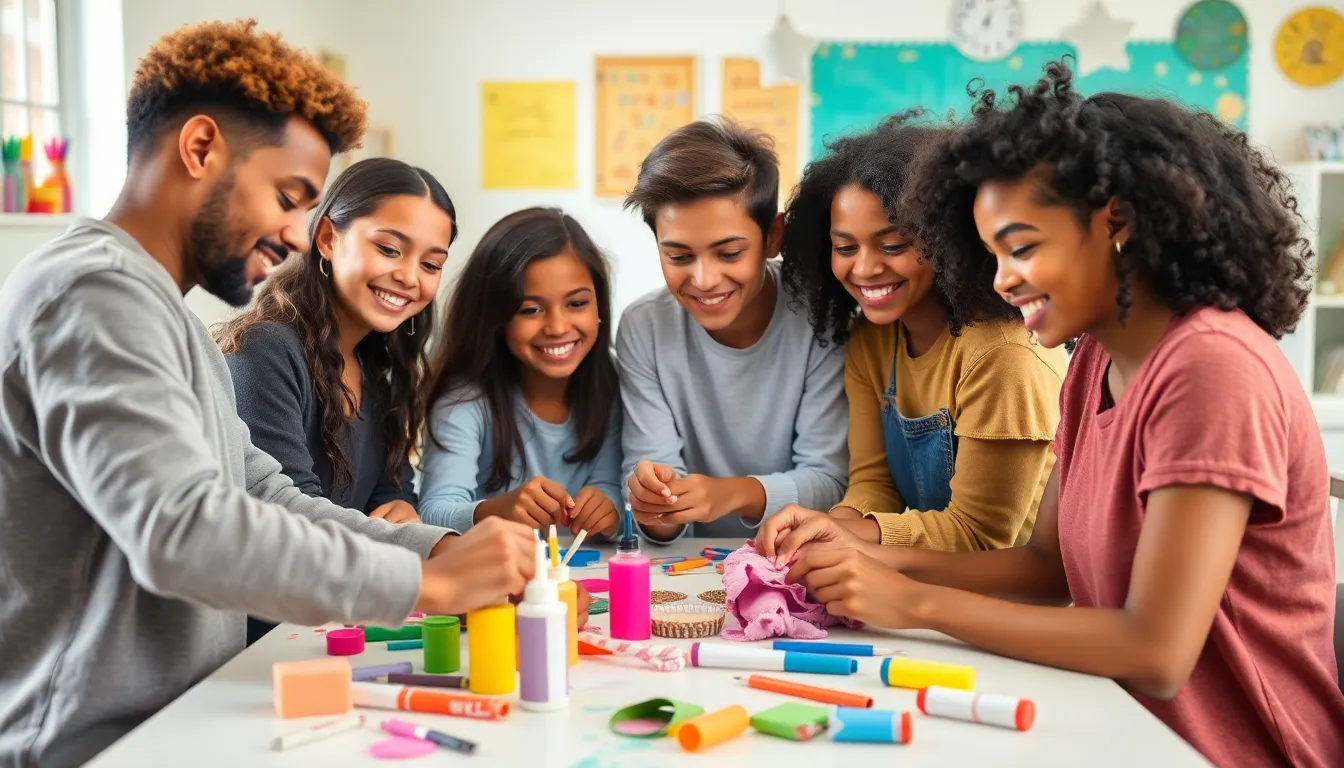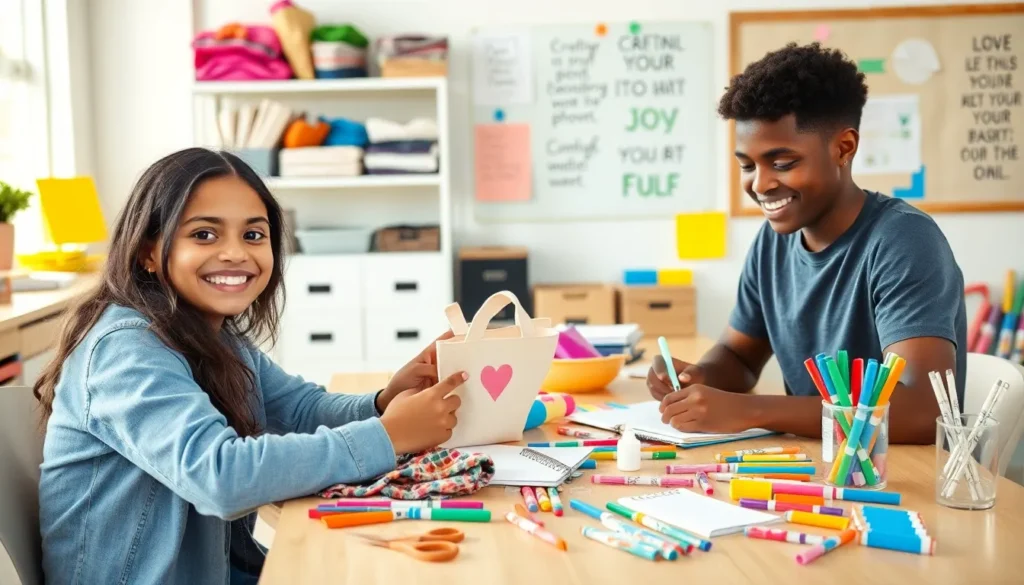In the whirlwind of student life, juggling classes, assignments, and social events can feel like trying to balance on a unicycle while juggling flaming torches. But what if there was a way to unleash creativity without sacrificing precious study time? Enter simple DIY projects—your new best friends that promise to transform mundane materials into masterpieces, all while keeping your wallet intact.
Table of Contents
ToggleSimple DIY Projects for Students
Creating simple DIY projects offers students an excellent way to manage stress and showcase creativity. Several projects require minimal materials and time, making them perfect for busy schedules.
- Personalized Tote Bags: Students can use fabric paint or markers to customize plain canvas tote bags. This project combines functionality with personal expression, allowing students to display unique designs.
- Photo Collage Boards: Making a photo collage board provides a canvas for memories. Students gather images and quotes, arranging them on a large poster board to create a visual representation of their experiences.
- Mason Jar Organizers: Transforming mason jars into organizers can enhance any study space. Students can spray paint jars in vibrant colors and label them for easy access to pens, pencils, and other supplies.
- DIY Dream Catchers: Crafting dream catchers helps students explore their artistic side. Utilizing feathers, beads, and string, they can create a personal piece that encourages relaxation and positivity.
- Custom Notebooks: Designing custom notebook covers allows students to express their style. They can use scrapbook paper, stickers, and glue to create one-of-a-kind notebooks tailored to their preferences.
- Homemade Scented Candles: Making scented candles offers a hands-on experience. Students can melt wax and add essential oils to create their favorite scents, providing both decoration and ambiance.
- Upcycled Plant Pots: Turning old containers into plant pots promotes sustainability. Students paint or decorate items like tin cans and yogurt containers before planting herbs or flowers, beautifying their environment.
Undertaking these DIY projects fosters creativity and provides a break from academic pressures. Each project encourages students to take initiative, making their space more personalized and enjoyable.
Benefits of DIY Projects

DIY projects provide tangible benefits for students, enriching their academic experience and personal development. Engaging in these activities fosters creativity while offering practical skills.
Enhancing Creativity
Students find that DIY projects stimulate their imagination and allow for self-expression. Personalizing items like tote bags or designing custom notebooks unleashes original ideas. Encouraging experimentation with different materials leads to innovative designs. Creative projects help students explore their interests and develop unique tastes. Additionally, the freedom to create without strict guidelines nurtures artistic thinking, benefiting problem-solving skills in academic settings.
Building Practical Skills
Hands-on DIY projects equip students with essential life skills. Working on tasks like making homemade scented candles or transforming mason jars into organizers teaches resourcefulness. Learning to handle tools and materials builds confidence and independence. Each project enhances time management skills, as students balance creation with academic responsibilities. Practical skills gained from DIY tasks, such as budgeting for materials, translate effectively to future career opportunities. Overall, these experiences prepare students for real-world challenges, fostering self-sufficiency.
Easy DIY Projects to Try
Students seeking creativity can enjoy several easy DIY projects that fit their schedules. These projects not only provide relaxation but also personalize living spaces and enhance practical skills.
Room Decor Ideas
Decorating a room can be simple and fun. Students can create wall art using canvas, acrylic paint, and stencils. Alternatively, they might try making string lights with photos clipped on. A personalized bulletin board made from cork tiles can help organize notes and inspire creativity. Students can even transform old t-shirts into throw pillows for a cozy touch. Each project uses minimal materials, making it easy to bring individual styles to any space.
Handy School Supplies
School supplies can be both functional and stylish. Students can upcycle tin cans into pencil holders by decorating them with washi tape or paint. They may also create custom planners using binder clips, scrapbook paper, and a hole punch. Fun bookmarks made from colorful cardstock keep places marked in textbooks. Crafting a DIY laptop sleeve from old jeans adds a unique flair while providing protection. All these items enhance the studying experience while showcasing personal creativity.
Fun Gifts for Friends
Making gifts adds a personal touch that’s appreciated. Students can craft friendship bracelets using embroidery thread in various colors. A simple DIY photo frame made from cardboard can display cherished memories. Homemade bath bombs, made from baking soda and essential oils, provide a relaxing treat. They may also create custom mugs using oil-based markers, perfect for personalized gifts. These projects foster connections while spreading joy among friends and peers.
Tips for Successful DIY Projects
DIY projects thrive on simplicity and fun. With the right approach, students can maximize creativity and minimize stress.
Selecting the Right Materials
Choosing appropriate materials elevates DIY projects. Consider using recycled items for eco-friendly options. Essential supplies may include scissors, glue, and paint, all of which are widely accessible. Popular choices also include fabric and decorative elements for customization. Test out local craft stores or online retailers for affordable deals. Ensure all materials complement the project requirements. Preparing all materials beforehand simplifies the crafting experience. Students can enhance their creations by mixing and matching colors and textures effectively.
Time Management Strategies
Effective time management is crucial for successful DIY projects. Prioritize projects by selecting simpler tasks first, ensuring manageable outcomes. Create a dedicated crafting schedule to prevent procrastination. Breaking down larger projects into smaller tasks helps maintain focus and avoids feeling overwhelmed. Set specific time limits for each task, allowing for breaks to refresh energy levels. Utilizing a timer can help track project progress and maintain motivation. Multitasking with simpler projects can also maximize productivity. Stick to a routine that accommodates academic responsibilities and personal interests for balanced engagement.
Simple DIY projects offer students a refreshing way to express their creativity while managing the demands of academic life. Engaging in hands-on activities not only provides a much-needed break from studies but also cultivates essential skills that can benefit them in the long run. By personalizing their spaces and creating unique items, students can enhance their well-being and foster connections with peers.
These projects serve as a reminder that creativity can thrive even in busy schedules. With minimal materials and time investment, students can explore their interests and develop resourcefulness. Ultimately, embracing DIY projects can lead to a more fulfilling and balanced student experience.

